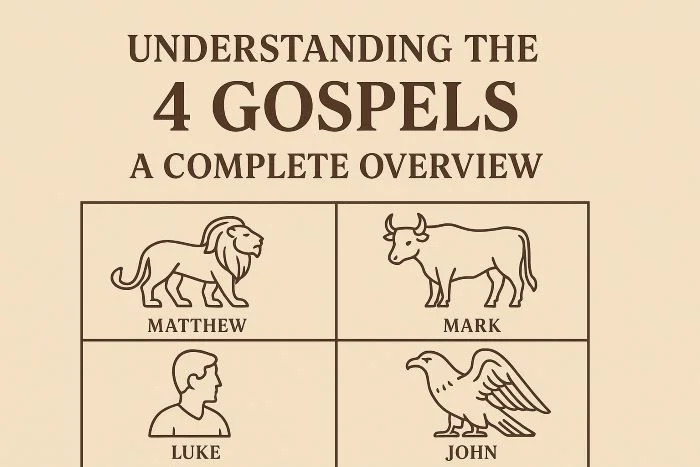
Do you ever wonder why the New Testament contains four different Gospels rather than just one? Wouldn’t a single account of the good news of salvation through Jesus Christ be enough? How should we understand the Gospels as works of literature? And what do the Gospels reveal about Jesus?
Each of the four Gospel writers offers a unique perspective on Jesus’ life, ministry, death, and resurrection — written to different audiences for different purposes. Together, they form a rich, multi-dimensional portrait of the Savior.
Fun Fact: The term “Gospel” comes from the Old English godspel, meaning “good news” or “glad tidings.”
Any one Gospel alone would not do full justice to the depth of Jesus’ life and work. Read together, they give us a fuller picture of Christ.
Gospel Symbols: Lion, Ox, Man, and Eagle
Early Christian tradition associated each Gospel with a symbolic creature, based on visions in Ezekiel and Revelation:
- Matthew – Lion ?: Symbol of kingship and royal authority.
- Mark – Ox ?: Represents service, strength, and sacrifice.
- Luke – Man ?: Symbolizes Jesus’ humanity, wisdom, and compassion.
- John – Eagle ?: Represents divine nature, soaring high into theological truth.
Trivia: In ancient churches, the four creatures were often depicted together at entrances, emphasizing the completeness of Christ’s story.
Capsule Summaries of the Four Gospels
1️⃣ Gospel of Matthew
- Audience: Primarily Jewish believers.
- Purpose: To show Jesus as the Messiah fulfilling Old Testament prophecies.
- Key Phrase: “That it might be fulfilled” (e.g., Matthew 1:22; 8:17).
- Themes:
- ? Kingdom of Heaven (God’s rule).
- ? Jesus as Teacher (Sermon on the Mount, Matthew 5–7).
- ? The Church (Matthew 16:18; 18:19).
- ? Second Coming of Christ (Matthew 24–25).
Fun Fact: Matthew quotes the Old Testament over 60 times, more than any other New Testament writer!

2️⃣ Gospel of Mark
- Audience: Roman Gentiles.
- Purpose: To portray Jesus as the Servant and Son of God.
- Key Word: “Immediately” (appears over 40 times!).
- Style:
- ? Fast-paced, action-oriented.
- ? Shortest Gospel.
- ? Emphasizes miracles and deeds over long discourses.
Fun Fact: Mark’s Gospel is often called the “Gospel of Action” because of its vivid storytelling and brisk movement.
Mark ends with a Roman centurion at the Cross proclaiming:
“Truly this man was the Son of God!” (Mark 15:39).

3️⃣ Gospel of Luke
- Audience: Gentiles (especially Greek-speaking).
- Purpose: To present Jesus as the universal Savior — compassionate, caring, and reaching all people.
- Key Phrase: “It came to pass” (e.g., Luke 2:15, KJV).
- Distinctives:
- ? Emphasis on women, the poor, and outcasts.
- ? Highlights joy, prayer, and the Holy Spirit.
- ? Contains more parables (like the Good Samaritan and Prodigal Son) than any other Gospel.
Trivia: Luke was a physician (Colossians 4:14) — perhaps explaining his attention to detail in healing miracles!
Luke also wrote the sequel to his Gospel: The Acts of the Apostles.

4️⃣ Gospel of John
- Audience: Universal (both Jews and Gentiles).
- Purpose: To reveal the divinity of Jesus and call readers to believe in Him.
- Key Word: “Believe” (used nearly 100 times!).
- Distinctives:
- ? Focuses on Jesus’ identity rather than just His deeds.
- ? Highlights seven miraculous signs (like turning water into wine, John 2:1–11).
- ? Features extended theological discourses, such as the Bread of Life (John 6) and the Good Shepherd (John 10).
Fun Fact: About 90% of John’s content is unique to his Gospel — not found in Matthew, Mark, or Luke!
John’s clear purpose:
“These are written that you may believe that Jesus is the Christ, the Son of God, and that believing you may have life in His name.” (John 20:31)

What Are the Synoptic Gospels?
The first three Gospels — Matthew, Mark, and Luke — are known as the Synoptic Gospels. The word synoptic comes from Greek roots meaning “seeing together.” They share a similar structure, many of the same stories, and often even the same wording.
Key similarities:
- Narrative style (chronological events).
- Focus on Jesus’ Galilean ministry.
- Emphasis on parables and miracles.
Key differences from John:
- John is more theological, less narrative.
- Unique events like the raising of Lazarus and the “I Am” statements.
Trivia: The “Synoptic Problem” is a scholarly term for the study of how these three Gospels are related in content and structure!
Final Thoughts
The four Gospels — Matthew, Mark, Luke, and John — offer a beautiful, harmonious portrait of Jesus Christ from different angles.
Together, they invite us not only to see but also to believe and follow the living Lord.
Whether you are just beginning your study or diving deeper, remember: each Gospel contributes a vital part to the full good news of salvation!
How the Gospels Spread
Before the four Gospels were written down, the accounts of Jesus’ life, teachings, death, and resurrection were shared orally. Early Christian communities were deeply committed to preserving these stories with care and accuracy.
As Christianity spread throughout the Roman Empire, the need to record the authentic message of Jesus became urgent. The written Gospels ensured that the truth about Jesus would remain consistent and accessible to believers across different regions and generations.
Frequently Asked Questions About the Four Gospels
❓ Why are there four Gospels instead of one?
Each Gospel provides a unique perspective on Jesus’ life, ministry, death, and resurrection, written to different audiences for different purposes. Together, they offer a fuller and more complete portrait of who Jesus is.
❓ What do the symbols of the Gospels mean?
The four symbols — lion (Matthew), ox (Mark), man (Luke), and eagle (John) — come from early Christian tradition and represent each Gospel’s distinctive portrayal of Christ: King, Servant, Savior, and Divine Son.
❓ Which Gospel was written first?
Most scholars believe the Gospel of Mark was written first, around AD 60–70. Matthew and Luke are thought to have used Mark as a source when writing their Gospels.
❓ What are the Synoptic Gospels?
Matthew, Mark, and Luke are called the Synoptic Gospels because they share a similar structure, content, and point of view. The word “synoptic” means “seeing together” in Greek.
❓ How do the Gospels differ from one another?
Each Gospel emphasizes different aspects of Jesus’ identity and mission:
- Matthew presents Him as the promised Messiah.
- Mark focuses on His role as the suffering Servant.
- Luke portrays Him as the Savior for all people.
- John reveals Him as the eternal Son of God.
Affiliate Disclaimer
This post contains affiliate links. If you click on one of the links and make a purchase, I may receive a small commission at no extra cost to you. I only recommend products I truly believe in and think will be beneficial to my readers. Thank you for supporting Biblical Christianity!
Recommended Resource:
The Four: A Survey of the Gospels
By Peter J. Leithart
The Gospels are a fourfold portrait of Jesus. Peter Leithart explores the unique view each gospel offers while showing their unified witness. This book unpacks gospel themes, literary structures, and how they connect with Old Testament prophecies. Ideal for anyone seeking a deeper understanding of Matthew, Mark, Luke, and John.


Thank you for this. Helps me to understand.
Do you know what John was referring to when he used the keyword Witness?
Hi Judy,
Thank you for dropping by and leaving a comment; I truly appreciate it.
Now to your question, here’s what Ligonier dot org has to say:
In the Gospel of John, the term “witness” is used to emphasize the importance of testimony in establishing the truth about Jesus Christ. John the Beloved, also known as John the Apostle, uses the word “witness” to refer to those who testify to the identity and mission of Jesus as the Son of God and the Savior of the world.
John’s Gospel presents several key witnesses to Jesus:
God the Father: Jesus said, “The Father who sent me bears witness about me” (John 8:18b).
Jesus Himself: Jesus testified about Himself, saying, “If I do bear witness about myself, my testimony is true, for I know where I came from and where I am going” (John 8:14).
The Holy Spirit: Jesus promised that the Holy Spirit would bear witness about Him (John 15:26).
Jesus’ Works: The miracles and works that Jesus performed in His Father’s name bear witness to His divine nature (John 10:25b).
Scripture: The Old Testament Scriptures bear witness to Jesus by prophesying His coming and the salvation He would bring (John 5:39).
John the Baptist: He came as a witness to testify about the light, referring to Jesus (John 1:6-7a).
Jesus’ Disciples: They were witnesses because they had been with Jesus from the beginning (John 15:27).
Individuals Who Encountered Jesus: People like the Samaritan woman at the well and the man born blind testified about their experiences with Jesus (John 4:29, John 9:25).
These witnesses collectively provide a compelling testimony to the truth of Jesus’ identity and mission.
I hope this answers your query.
Blessings to you!
I find this article to be of great help to me and appreciate your efforts in making it available.
God bless.
I’m delighted to know that, Dr. Tommy.
Thank you for visiting.
God bless you more ?.